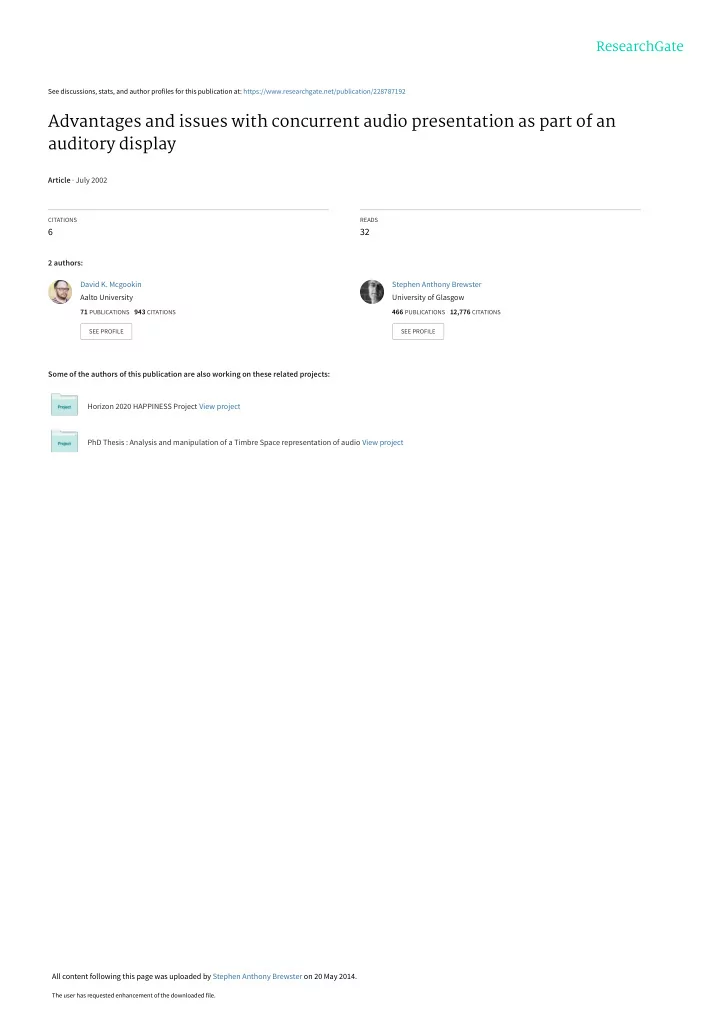

See discussions, stats, and author profiles for this publication at: https://www.researchgate.net/publication/228787192 Advantages and issues with concurrent audio presentation as part of an auditory display Article · July 2002 CITATIONS READS 6 32 2 authors: David K. Mcgookin Stephen Anthony Brewster Aalto University University of Glasgow 71 PUBLICATIONS 943 CITATIONS 466 PUBLICATIONS 12,776 CITATIONS SEE PROFILE SEE PROFILE Some of the authors of this publication are also working on these related projects: Horizon 2020 HAPPINESS Project View project PhD Thesis : Analysis and manipulation of a Timbre Space representation of audio View project All content following this page was uploaded by Stephen Anthony Brewster on 20 May 2014. The user has requested enhancement of the downloaded file.
Proceedings of the 12 th International Conference on Auditory Display, London, UK June 20 - 23, 2006 ADVANTAGES AND ISSUES WITH CONCURRENT AUDIO PRESENTATION AS PART OF AN AUDITORY DISPLAY David K. McGookin, Stephen A. Brewster Glasgow Interactive Systems Group, Department of Computing Science, University of Glasgow, Glasgow, G12 8QQ { mcgookdk,stephen } @dcs.gla.ac.uk http://www.dcs.gla.ac.uk/ ∼{ mcgookdk, stephen } ABSTRACT work which may improve our understanding of concurrently pre- sented sound is outlined. This paper presents an overview of the concurrent presentation of sound as part of an auditory display. The reasons why designers would wish to use concurrent sound presentation (such as increas- 2. WHY USE CONCURRENT AUDIO PRESENTATION? ing communication bandwidth and allowing comparisons between data to be more easily made) are discussed and examples given. There are several reasons why concurrent audio may be of use as The paper then discusses the problems that can occur when sounds part of an auditory display. In this section several advantages are are concurrently presented before summarising and critically eval- outlined and work that seeks to exploit these advantages is dis- uating work by the authors on the identification of concurrently cussed. presented earcons. 2.1. Increased Bandwidth of Communication 1. INTRODUCTION One advantage of concurrent auditory displays is their ability to The field of auditory display has matured over the last few years to increase the rate of information which can be presented to a user. provide clear, evaluated methods, to allow designers to exploit the This means that information can be pertinently delivered, without having to be delayed until other auditory messages have finished advantages that sound can bring to a human computer interface. Further advantages have emerged over the last few years such as playing. Whilst auditory displays can be designed to associate a priority to each message delivered to a user [1], there may be sev- spatialisation of sound which has lead to a number of researchers working with concurrent audio presentation, where more than one eral instances where messages are of equal importance to the sys- sound is presented to a user at a time, which may be of specific ad- tem, and it is up to the user to determine which message is of great- est importance. Several systems such as the ARKola [2] bottling vantage with mobile computing devices such as mobile telephones and personal digital assistants (PDAs). Such devices are becoming plant simulator, and Nomadic Radio [3], have used this technique to allow the user, rather than the system, to determine what data increasingly more popular, with greater functionality constantly being added by manufacturers. The usability of these devices is, are and are not important, and therefore what should be attended to. Consider for example, the “diary in the sky” system by Walker however, open to debate as mobile computing has several usability et al. [4], which used a spatialised audio environment to encode issues that need to be addressed. Notably, due to the form factor of mobile devices, the visual display space available is severely the times of certain diary appointments. Sounds were consecu- tively presented according to their time of appointment. If a user limited in comparison to other computing devices, such as the per- sonal computer. For example, the Palm Tungsten PDA has a dis- remembered that they had something important scheduled at 9PM, but could not remember what it was, they would need to consec- play of only 6x6 cm. The low resolutions of such displays also contribute to limiting the amount of data that can be useably pre- utively listen to all of the appointments up to 9PM before reach- sented. Also, because mobile computer users are likely to be on ing the information required, which may take a long time (around eight seconds for four appointments). If all of the diary entries the move whilst using their device, they cannot devote their entire attention to the computing task. They must constantly monitor the were presented in parallel, the user could make use of the cocktail party effect [5], to “tune in” to the 9PM appointment, reducing the environment for danger and react accordingly. This places further strain on the user’s visual resource. The use of concurrent audio time taken to locate the required information. may provide a solution with this problem. Such an application of concurrently presented audio may be of This paper discusses the ways in which concurrent audio has specific use with mobile computing interfaces which, as previously been used by auditory display designers, and the advantages that discussed, suffer from both small screen displays [6], and users it provides. The disadvantages of concurrent audio are then dis- not being able to constantly attend to that visual display in the cussed followed by a critical summary of work undertaken to iden- same way as with a desktop computer [7]. Concurrent audio may tify and understand these problems as regards concurrent earcon allow for more information to be presented through audio and thus identification. Finally conclusions are drawn and possible future relieve some of the demands on a user’s visual resource. ICAD06-1
Recommend
More recommend